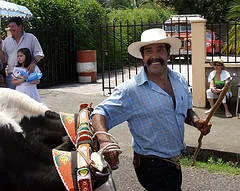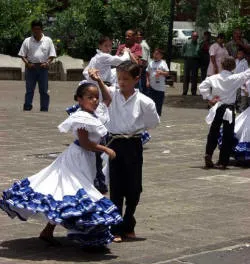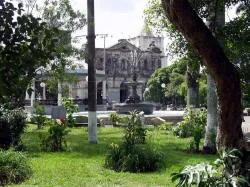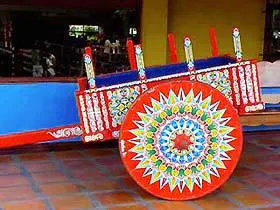The Costa Ricans

Costa Ricans (Ticos) are generally gentle, spirited, friendly, educated, polite, and kind people. Most seem to like visitors from other countries and treat them well. There are, of course, exceptions, but on the whole, you can expect to be made welcome wherever you go.
Ticos are a mixing of races. Though most of the country’s 4 million inhabitants descend from Spanish immigrants, many families originated in other parts of Europe, Asia, Africa and Central America. A large number are fair-skinned, especially in the Central Valley. In the outlying areas, more people are mestizos, a mixture of European and Indigenous blood. On the Caribbean coast you find strong links to African lineage, and in Talamanca Mountain, you will find it inhabited by the pure-blooded Indians of various tribes. In Guanacaste Province, you will find Ticos dark skinned reflecting their Nicaraguan heritage.
Ticos are extremely family oriented and love music and dance. When I say love music, I mean it is everywhere and all the time… and LOUD. They also occasional enjoy alcohol. In fact, Costa Ricans, as almost all Latinos, party loud and long and really enjoy each other’s company. You will definitely know if there is a party in your neighborhood! Not unexpectedly, you probably won’t get invited to those parties until you speak the language! That is why you will see me repeat time and again in this site, Learn Spanish if you plan to live here. It makes all the difference.
If you are married to a Costa Rican or have a Tico(a) as your significant other (pareja), you not only get him or her, you get the whole clan, and in Catholic Costa Rica, that can be a TON of relatives! Click here for one entry from my personal blog on this subject.
Who are these people?

They have the same goals, desires and fears you do. They want to love and be loved, they want their children to be educated, they worry about their teenagers getting tongue rings and tattoos, they worry about the guy their daughter is dating, and they want to thrive and prosper. They want their children to have better lives than they do. They worry about politics, Iraq, crooked politicians, and the economy. Sound familiar?
Ticos are often polite to the extreme. Most will do almost anything to avoid a confrontation or appear rude in any way. This can cause MUCH confusion to foreigners, especially North Americans who tend to be very direct. If a Tico feels a “no” answer would in any way offend, they may well say “yes” or “maybe”, or “I think so” or “that might be difficult”, which is still pretty much means “no”, but sounds more polite! Easy Huh?
Many visitors, especially from the US, find this a tad difficult to comprehend. We North Americans tend to be direct and straight forward. Those from New York may be even a bit more, ahem, direct. If you plan to live here for any length of time, my suggestion would be to listen carefully, be patient, respect their culture (it’s only about 1,000 years OLDER than our culture in the US), and act like you are a gu
est… which you are!
Those who come here to live will be subject to culture shock. If take few minutes to read our section on culture shock before arriving and you adjustment to life here will be significantly easier.
What religion is the most popular, and do I have to learn Spanish to live or visit there?

RicaThe predominant religion is Catholic. Nearly every town has a Catholic church and many have a football (soccer) field in front of the church! In Costa Rica, football rules. There are many spectacular churches here in Costa Rica, some over three hundred years old like the one in this photograph to the right.
The language is Spanish, though some Ticos speak English fairly well, especially if they work in tourism. If you are just visiting, you won’t have to know how to speak Spanish. But if you plan to live here, you simply have to learn Spanish in order to truly adjust and feel like you’re fitting in. While you can exist here and not speak the language, you’ll never really live here until you have down the basics. More important, to do so shows you are respectful of them, their culture, and their country. Always be aware that you will always be a guest, regardless of your residency or citizenship status. Remember too that just because an individual does not speak English does not make him stupid. So… when you DO meet someone, and you will… a store clerk, waiter, or other person who doesn’t speak your language, don’t talk louder. It won’t help! They are not deaf nor stupid. They just don’t speak your language. They speak theirs.
Why do I see those painted oxcarts everywhere?
A Symbol Of Costa Rica
If there is a national symbol of Costa Rica, other then the flag, it is the oxcart. Oxcarts were used to haul coffee and other items to market in the early days of Costa Rica. Even today, on rural back roads, you will see an occasional country dweller (campasino) driving an oxcart (with oxen!). They also appear in many parades, horse shows (topes), and many festivals. Most are hand painted as is the one in this photo.
Some tourist spots sell them to be shipped back to their own country for use in homes and there have been converted to dry bars.
Strong cultural ties and tradition are everywhere. Ticos are very proud of their culture and proud to be a nation of peace. This focus on the culture, the family, hard work, and the love of life can be seen everywhere,
Below is a movie made in 1947 and while things have changed, the basics are the same.
For those of you who are thinking “Hey… that doesn’t look like the San Jose Airport…”, it really is! For many years the airport was not in its current location in Alajuela. It was located in the center of what is today Parque La Sabana!
And if any of you are wondering about that lovely swimming hole…. it is still there. It is located about 15km from San Jose near San Antonio de Belén and is called the Ojo de Aqua. Something around 5,000 gallons of spring water gushes out per minute means no chlorination is needed. The water completely changes 12 times per day/
Why are they called Ticos?
Ticos is the collective common name that Costa Ricans cell themselves. More specifically, a Tica is a female Costa Rican and a Tico is a male.
The name comes from a preference Ticos have of using the diminutive in their speech. By diminutive, I mean they change everything so it means ‘little something’. For instance, a Tico might call his grandmother (abuela), abuelita, or her house (casa) her casita. A kiss (beso) becomes a besito! This goes on and on and covers almost everything. In fact, it makes learning Costa Rica style Spanish a bit harder as you have to learn these diminutives even if you don’t use them. So why Tico? Because many people pronounced the diminutive saying momentito (meaning just a short moment), as “momentico”. I seldom hear the old …ico thing any more, but the …ito or …ita thing is alive and well.
Why do Latinos always look so dangerous? (Believe it or not… I get asked this a LOT!)
To whom? North Americans? They certainly don’t look dangerous to each other!
Here is my personal opinion: I blame it on Hollywood! For many years, the ‘bad guys’ in movies and on TV always were the dark, swarthy types. Heavy 5 o’clock shadow, black hair, often dark clothing, dark complexions, etc. In other words, Latin! The good guys always were clean shaven, wore white and generally looked… well… like North Americans. Now this has changed a bit in recent years, but I think we have been trained to look for the bad guy image. When we see it, we get nervous. Ignore it.









